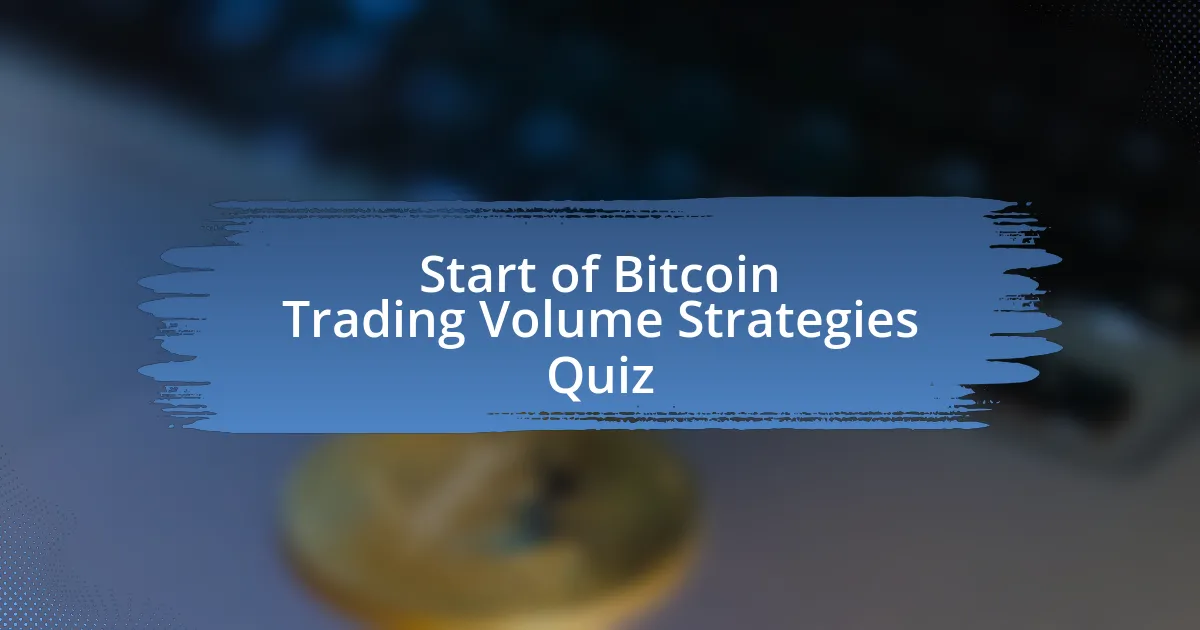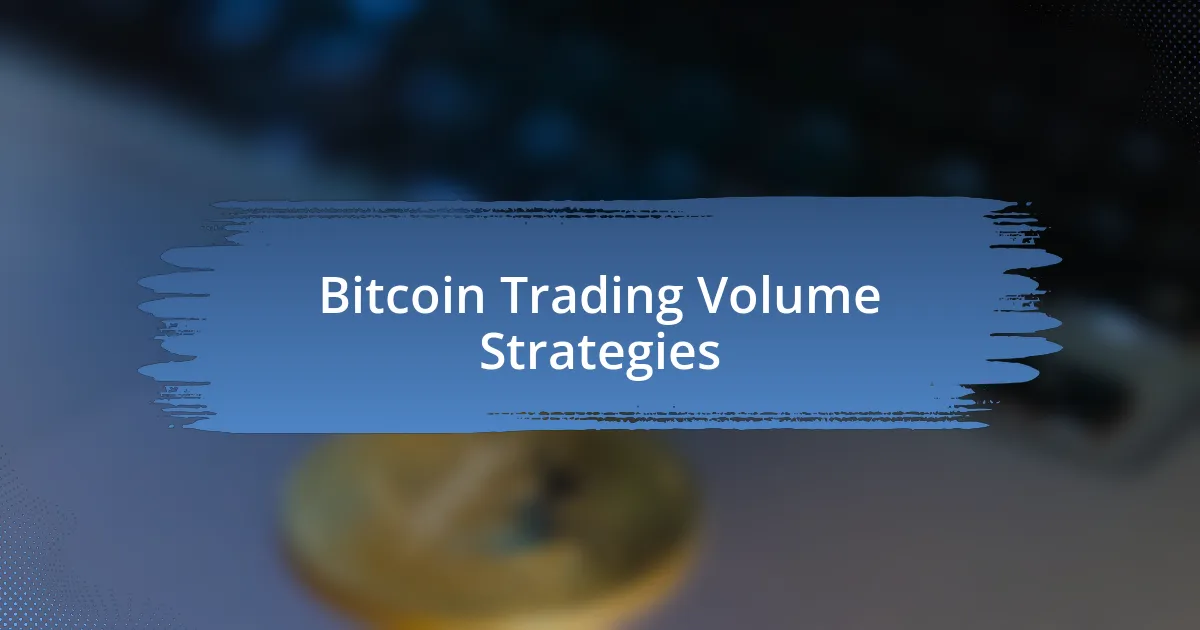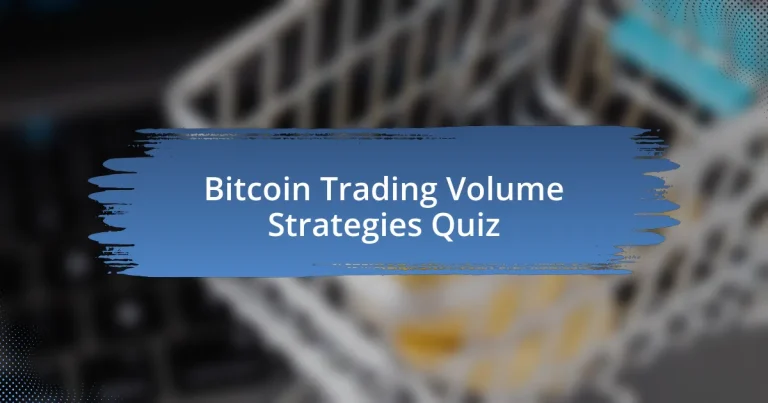
Start of Bitcoin Trading Volume Strategies Quiz
1. What are some strategies for high volume cryptocurrency trading?
- Scalping, breakout trading, and trend following.
- Stacking, layering, and wait and see approach.
- Buy and hold strategy, arbitrage, and diversification.
- Long term investment, asset allocation, and portfolio management.
2. What is the purpose of the On Balance Volume (OBV) indicator?
- It measures the overall volatility of the market.
- It predicts future prices based on past trends.
- It helps traders analyze the relationship between price and volume.
- It indicates the sentiment of individual investors.
3. How does the OBV indicator calculate its values?
- It adds the current trading volume to a running total if the price increases or subtracts it if the price decreases.
- It counts the total number of trades executed during the day.
- It averages the price over a specific period based on trading volume.
- It measures price fluctuations without considering volume changes.
4. What is the significance of volume trends in cryptocurrency markets?
- They suggest that prices will always fall regardless of trading volume.
- They indicate potential losses in trading activity and investor confidence.
- They show that volume trends are irrelevant to cryptocurrency investments.
- They provide valuable clues about market sentiments and potential price movements.
5. What can a significant increase in trading volume indicate?
- Consistent trading patterns without major shifts.
- Strong buying or selling pressure, potentially leading to a price breakout or trend reversal.
- Decreased interest in the asset, suggesting a price decline.
- Stabilization of prices, indicating market balance.
6. How can false signals occur during periods of high volume?
- Because of higher fees during busy trading hours.
- Due to market manipulation, speculative trading, or sudden shifts in sentiment.
- As a result of increased regulatory scrutiny.
- Owing to technical failures in trading platforms.
7. What is the Money Flow Index (MFI)?
- A statistical measure that assesses the volatility of a cryptocurrency.
- An oscillator-based volume indicator that measures the flow of money into and out of a cryptocurrency.
- A price chart pattern indicating potential breakouts in trading.
- A type of market sentiment indicator that predicts future price trends.
8. What does the MFI indicate?
- Current market liquidity levels.
- General trading volume trends.
- Only price fluctuations in the market.
- Overbought and oversold conditions in the market.
9. What is the Volume Weighted Average Price (VWAP)?
- A technique for analyzing market cap changes in the cryptocurrency market.
- A tool that measures the total number of transactions in a market over time.
- A popular volume indicator that calculates the average price of a cryptocurrency over a specified period, weighted by trading volume.
- A method used to forecast future prices based on historical price patterns.
10. How is VWAP used in trading?
- To determine the volatility of market prices.
- To calculate average market sentiment.
- To identify potential support and resistance levels.
- To predict economic indicators and trends.
11. What does a high volume concentration indicate in the context of the VPSV indicator?
- Significant buying or selling interest at that level.
- The exact price of a cryptocurrency is known.
- Decreased market volatility at that price.
- Unrelated trading patterns with no significant impact.
12. How can traders use volume analysis to make informed trading decisions?
- By analyzing volume metrics such as traded volume, volume bars, and volume oscillators.
- By focusing solely on news events and ignoring trading activity.
- By relying exclusively on historical price patterns regardless of volume.
- By tracking daily price changes without any volume context.
13. What is the importance of integrating volume analysis with other market indicators?
- It isolates volume from other critical market trends and patterns.
- It complicates trading processes by introducing unnecessary metrics.
- It decreases the effectiveness of other indicators by adding noise.
- It enhances trading strategies by providing a more comprehensive understanding of market dynamics.
14. What happens when there is convergence between high trading volume and bullish price action?
- It can provide confirmation for potential upward price movements.
- It causes unpredictable price fluctuations.
- It suggests no significant market movement.
- It indicates a guaranteed price drop.
15. What happens when there is divergence between volume and price?
- It guarantees a price increase.
- It ensures constant trading volume.
- It indicates stable market conditions.
- It can signal potential market reversals.
16. What are the different types of volume indicators used in cryptocurrency trading?
- Exponential Moving Average (EMA), Bollinger Bands (BB), and Parabolic SAR.
- Fibonacci Retracement, Average Volume, and Simple Moving Average (SMA).
- Relative Strength Index (RSI), Moving Average Convergence Divergence (MACD), and Average True Range (ATR).
- On-Balance Volume (OBV), Money Flow Index (MFI), and Volume Weighted Average Price (VWAP).
17. What does a rising OBV indicate?
- Increased selling and bearish trends.
- Decreased demand and possible downtrends.
- Increased buying and potential uptrends.
- No change in market direction.
18. What does a falling OBV indicate?
- Uncertain market conditions and price neutrality.
- Rising selling pressure and possible downtrends.
- Decreased trading volume and market stability.
- Increased buying pressure and potential uptrends.
19. How can traders use the OBV to confirm or predict trend reversals?
- By relying solely on the price action without considering volume.
- By waiting for prolonged downtrends to automatically reverse.
- By ignoring any changes in trading volume during price movement.
- By looking for discrepancies between the cryptocurrency’s price trend and OBV movement.
20. What is the significance of high-volume areas in a volume profile?
- They highlight unimportant trading activity.
- They show randomly fluctuating price movements.
- They indicate strong interest and potential support or resistance zones.
- They reflect only selling pressure in the market.
21. How does a volume profile reflect market sentiment?
- High price fluctuations mean high market sentiment regardless of volume.
- High trading volumes at certain price levels indicate strong buying or selling pressure.
- Price levels that see consistent volume drops represent bullish sentiment.
- Low trading volumes suggest market apathy and disinterest.
22. What is VPFR (Volume Profile Fixed Range)?
- An indicator for predicting future price movements.
- A method for calculating average trading volume.
- A tool used to analyze the volume profile over a fixed range.
- A technique for tracking price changes over time.
23. How can traders use the volume profile to identify areas of accumulation or distribution?
- By tracking how many traders are online at a time.
- By observing trends in social media sentiment.
- By comparing the number of trades in different markets.
- By analyzing the volume at various price levels.
24. What is the role of volume indicators in predicting cryptocurrency price movements?
- They demonstrate changing trading volume over time, indicating the strength of the current trend.
- They predict future price trends based solely on historical data.
- They only reflect trader sentiment without considering volume.
- They show the moving average of a cryptocurrency`s price exclusively.
25. What does increasing volume indicate in a positive price movement?
- An impending market crash.
- A strong trend that is likely to continue.
- A shift to bearish sentiment.
- A temporary increase in volatility.
26. What are some popular volume indicators used in cryptocurrency trading?
- Exponential Moving Average (EMA)
- Price Momentum Oscillator (PMO)
- Relative Strength Indicator (RSI)
- On-Balance Volume (OBV), Money Flow Index (MFI), and Accumulation/Distribution Line.
27. How does the Accumulation/Distribution Line work?
- It indicates the exact amount of cryptocurrency traded daily.
- It reflects only price changes without considering volume.
- It predicts future prices based solely on historical data.
- It measures the flow of money into and out of a cryptocurrency by combining price and volume data.
28. What is the significance of Chaikin Money Flow in cryptocurrency trading?
- It forecasts the technological advancements in blockchain.
- It measures the profitability of individual cryptocurrencies.
- It indicates the overall market capitalization of cryptocurrencies.
- It helps predict buy/sell signals by analyzing money flow.
29. How can traders use volume indicators to analyze buy/sell signals?
- By ignoring volume fluctuations and focusing solely on price changes.
- By tracking changing trading volume over time to identify strong trends.
- By analyzing historical price patterns without considering volume trends.
- By following news headlines without correlating them to volume data.
30. What is the main function of technical indicators in cryptocurrency trading?
- To track the popularity of various cryptocurrencies in social media.
- To solely analyze the aesthetic appeal of trading platforms.
- To measure the emotional responses of cryptocurrency traders.
- To predict market direction based on historic price movement, cryptocurrency volume, and other information.

Congratulations on Completing the Quiz!
You’ve just completed the quiz on Bitcoin Trading Volume Strategies, and that’s a great achievement! This exercise has likely reinforced your understanding of how trading volume influences market behavior. You may have discovered effective strategies and learned how to interpret trading volume changes effectively. Every question has aimed to deepen your knowledge in this rapidly evolving field.
Reflecting on the quiz, it’s clear that understanding trading volume is crucial for making informed decisions. You may have gained insights into how volume can signal market trends or reversals. By applying these concepts, you can enhance your trading strategy and potentially improve your outcomes in the Bitcoin market.
If you’re eager to expand your knowledge even further, we invite you to explore the next section on Bitcoin Trading Volume Strategies. It offers in-depth information and practical tips to help you navigate trading more effectively. Dive deeper into this topic and elevate your trading skills today!

Bitcoin Trading Volume Strategies
Understanding Bitcoin Trading Volume
Bitcoin trading volume refers to the total amount of Bitcoin that is traded within a specific time frame. It indicates market activity and liquidity. High trading volume often signals strong investor interest and can influence price movements. Analyzing trading volume helps traders gauge the strength of price trends. Studies show that increased trading volume often precedes significant price changes.
Analyzing Volume with Price Trends
Volume analysis involves examining the relationship between trading volume and price trends. When prices rise with increasing volume, it indicates a strong trend. Conversely, if prices rise but volume decreases, the trend may lack strength. This relationship can help traders confirm potential buy or sell signals, enhancing decision-making in trade execution.
Volume Indicators in Trading Strategies
Various indicators utilize trading volume to inform strategies. Tools like the Volume Weighted Average Price (VWAP) and On-Balance Volume (OBV) leverage volume data to signal market momentum. VWAP helps traders identify average prices considering trading volume, while OBV connects volume changes to price movement. These indicators become essential in devising entry and exit strategies.
Volume in Market Sentiment Analysis
Trading volume reflects market sentiment, illustrating the emotional state of traders. High volume during price increases signals bullish sentiment, while high volume during declines suggests bearish sentiment. Understanding these dynamics aids traders in assessing potential market shifts, aligning their strategies with prevailing moods in the market.
Implementing Volume-Based Risk Management
Volume-based risk management strategies focus on adjusting trade size based on trading volume. By correlating risk levels with volume, traders can mitigate losses during low liquidity periods. Techniques include reducing exposure when volume is low and increasing it when volume is high. This proactive approach enhances overall trade performance and capital preservation.
What are Bitcoin Trading Volume Strategies?
Bitcoin trading volume strategies refer to techniques used by traders to analyze and leverage the volume of Bitcoin traded in the market. These strategies help investors identify market trends and potential price movements based on the volume of trades. For example, high trading volume can indicate strong interest in Bitcoin, suggesting possible price increases, while low volume may signal a lack of interest and potential declines.
How do traders analyze Bitcoin Trading Volume?
Traders analyze Bitcoin trading volume using various analytical tools and indicators, such as volume charts and the Volume Weighted Average Price (VWAP). They compare volume levels with price movements to identify patterns, such as divergence, where price moves in the opposite direction of volume changes. This analysis helps traders make informed decisions about when to buy or sell Bitcoin. Historical data shows that significant price movements often follow volume spikes.
Where can traders find Bitcoin Trading Volume data?
Traders can find Bitcoin trading volume data on various cryptocurrency exchanges, market tracking websites, and trading platforms. Websites like CoinMarketCap and TradingView provide comprehensive data on trading volume across different exchanges. This data is important for assessing liquidity and market dynamics, as it enables traders to monitor the overall activity in the Bitcoin market.
When is trading volume most important in Bitcoin trading?
Trading volume is most important during key market events, such as price surges, regulatory announcements, or major technological updates. These events typically lead to increased trading activity, which can signify volatility and trading opportunities. Historical patterns show that heightened volume often precedes significant price movements, making it critical for effective trading strategies.
Who benefits from using Bitcoin Trading Volume Strategies?
Both individual and institutional traders benefit from using Bitcoin trading volume strategies. Individual traders use these strategies to make informed decisions and improve their trading outcomes. Institutional traders utilize sophisticated algorithms and analytics to optimize their trading, managing larger volumes and seeking to capitalize on market trends driven by trading activity.


